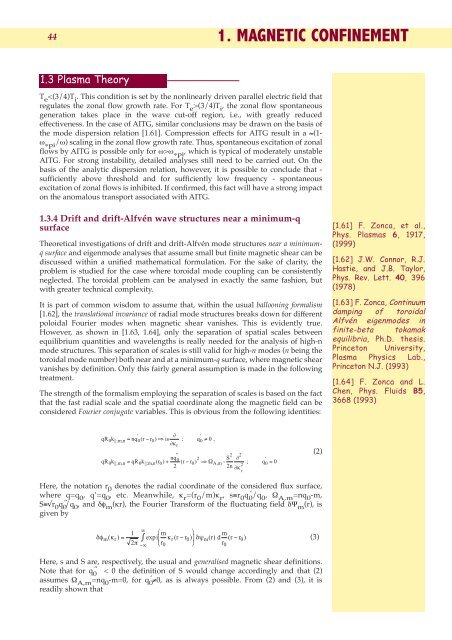1. magnetic confinement - ENEA - Fusione
1. magnetic confinement - ENEA - Fusione
1. magnetic confinement - ENEA - Fusione
You also want an ePaper? Increase the reach of your titles
YUMPU automatically turns print PDFs into web optimized ePapers that Google loves.
44<br />
<strong>1.</strong> MAGNETIC CONFINEMENT<br />
<strong>1.</strong>3 Plasma Theory<br />
T e (3/4)T i , the zonal flow spontaneous<br />
generation takes place in the wave cut-off region, i.e., with greatly reduced<br />
effectiveness. In the case of AITG, similar conclusions may be drawn on the basis of<br />
the mode dispersion relation [<strong>1.</strong>61]. Compression effects for AITG result in a ≈(1-<br />
ω ∗pi /ω) scaling in the zonal flow growth rate. Thus, spontaneous excitation of zonal<br />
flows by AITG is possible only for ω>ω ∗pi , which is typical of moderately unstable<br />
AITG. For strong instability, detailed analyses still need to be carried out. On the<br />
basis of the analytic dispersion relation, however, it is possible to conclude that -<br />
sufficiently above threshold and for sufficiently low frequency - spontaneous<br />
excitation of zonal flows is inhibited. If confirmed, this fact will have a strong impact<br />
on the anomalous transport associated with AITG.<br />
<strong>1.</strong>3.4 Drift and drift-Alfvén wave structures near a minimum-q<br />
surface<br />
Theoretical investigations of drift and drift-Alfvén mode structures near a minimumq<br />
surface and eigenmode analyses that assume small but finite <strong>magnetic</strong> shear can be<br />
discussed within a unified mathematical formulation. For the sake of clarity, the<br />
problem is studied for the case where toroidal mode coupling can be consistently<br />
neglected. The toroidal problem can be analysed in exactly the same fashion, but<br />
with greater technical complexity.<br />
It is part of common wisdom to assume that, within the usual ballooning formalism<br />
[<strong>1.</strong>62], the translational invariance of radial mode structures breaks down for different<br />
poloidal Fourier modes when <strong>magnetic</strong> shear vanishes. This is evidently true.<br />
However, as shown in [<strong>1.</strong>63, <strong>1.</strong>64], only the separation of spatial scales between<br />
equilibrium quantities and wavelengths is really needed for the analysis of high-n<br />
mode structures. This separation of scales is still valid for high-n modes (n being the<br />
toroidal mode number) both near and at a minimum-q surface, where <strong>magnetic</strong> shear<br />
vanishes by definition. Only this fairly general assumption is made in the following<br />
treatment.<br />
The strength of the formalism employing the separation of scales is based on the fact<br />
that the fast radial scale and the spatial coordinate along the <strong>magnetic</strong> field can be<br />
considered Fourier conjugate variables. This is obvious from the following identities:<br />
[<strong>1.</strong>61] F. Zonca, et al.,<br />
Phys. Plasmas 6, 1917,<br />
(1999)<br />
[<strong>1.</strong>62] J.W. Connor, R.J.<br />
Hastie, and J.B. Taylor,<br />
Phys. Rev. Lett. 40, 396<br />
(1978)<br />
[<strong>1.</strong>63] F. Zonca, Continuum<br />
damping of toroidal<br />
Alfvén eigenmodes in<br />
finite-beta tokamak<br />
equilibria, Ph.D. thesis.<br />
Princeton University,<br />
Plasma Physics Lab.,<br />
Princeton N.J. (1993)<br />
[<strong>1.</strong>64] F. Zonca and L.<br />
Chen, Phys. Fluids B5,<br />
3668 (1993)<br />
'<br />
∂ '<br />
qR0k||; mn , = nq0( r −r0)<br />
⇒i s ; q0<br />
≠0<br />
,<br />
∂κr<br />
''<br />
nq<br />
S<br />
qR0k mn qR0k mn r 0<br />
0 r r0 2 2<br />
∂<br />
'<br />
||; , = ||; , ( ) + ( − ) ⇒ ΩAm<br />
, - ; q<br />
n<br />
22 0 = 0<br />
2 2 ∂κ<br />
r<br />
(2)<br />
Here, the notation r 0 denotes the radial coordinate of the considered flux surface,<br />
where q=q 0 , q’=q 0 ’ , etc. Meanwhile, κ r =(r 0 /m)κ r , s≡r 0 q 0 ’ /q 0 , Ω A,m =nq 0 -m,<br />
S≡√r 0 q 0 ” /q 0 , and δφ m (κr), the Fourier Transform of the fluctuating field δΨ m (r), is<br />
given by<br />
∞<br />
1 ⎛ m ⎞ m<br />
δφm( κr) = ∫ exp i ⎜ κr( r−<br />
r0) ⎟ δψm( r) d ( r−<br />
r0)<br />
2π<br />
−∞ ⎝r0<br />
⎠ r0<br />
(3)<br />
Here, s and S are, respectively, the usual and generalised <strong>magnetic</strong> shear definitions.<br />
Note that for q 0<br />
” < 0 the definition of S would change accordingly and that (2)<br />
assumes Ω A,m =nq 0 -m=0, for q 0 ’ ≠0, as is always possible. From (2) and (3), it is<br />
readily shown that













